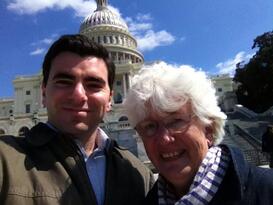By Adam Levitin and Susan Wachter
This is an explanation of the housing bubble and collapse from scholars highly influential among congressional Democrats, arguing in sum that the post-New Deal regulated housing market worked well and that the bubble resulted from the growth of unregulated private-label mortgage backed securities in the mid-2000s.
Early in the book, they include a straightforward defense of homeownership, as opposed to renting, as a goal worth pursuing through government policy, an assumption that shapes a lot of their analysis and recommendations: “A nation of homeowners is a nation in which all households share in the prosperity that has generally gone with homeownership and in which all households are protected from the risk faced by renters -- the risk of being priced out of one’s own community by gentrification, inflation, and economic growth” -- thus a guard against inequality.
The first half of the book is a narrative of the mortgage market from its beginnings through the crisis. It starts with the pre-Depression housing market, which featured only short-term, interest-only “bullet loans,” continues through the New Deal and into the pre-bubble dominance of the Government-Sponsored Enterprises Fannie Mae and Freddie Mac, and ends with the bubble being created by the return of "nontraditional" mortgages. Briefly:
- In response to mass defaults at the outset of the Depression, the government created the Federal Home Loan Bank system to make loans against mortgage collateral and the HOLC, which directly purchased defaulted mortgages and packaged into marketable securities. The HOLC was temporary, but demonstrated that such a market was feasible (but its legacy was tarnished with association with redlining).
- 1934: National Housing Act
- Federal Housing Administration created to directly encourage mortgage lending and homebuilding.
- Fannie Mae created to buy insured mortgages and create a secondary market
- Together, those defined the regulated secondary market.
- 1934: National Housing Act
- Note that the 30-year fixed rate mortgage had its origins in the war: In 1944, Congress authorized the VA to guarantee loans for soldiers returning from war. To make payments affordable, it eventually settled on 30 years. That was then adopted by the FHA as well, and became standard.
- 1970: Freddie Mac created to serve S&Ls, not to compete with Fannie
- By the 1990s, the now-liberalized GSEs had about half the market, and S&Ls had faded. In Levitin and Wachter’s view, it was a time of market stability and rising homeownership.
- But in the mid-2000s, the growth of the Private-Label Securities market allowed for nontraditional mortgages.
- “Freed of its New Deal regulations, the U.S. mortgage market quickly reverted to Depression-era “bullet” loans, shifting interest rate and refinancing risk back to borrowers.”
- “PLS made the expansion in the non-traditional mortgage market possible, and non-traditional mortgages made the expansion of the PLS market possible. Without PLS, most non-traditional mortgages would not have been originated because banks would simply have been unwilling to carry the risks from non-traditional mortgages on their balance sheets.”
The second half of the book is their analysis of the bubble and crisis.
They start out by arguing that the bubble was a supply-side phenomenon: The risks of subprime mortgages rose while pricing (versus risk-free Treasurys) fell, even as volume increased, suggesting a rightward shift of supply curve.
Then, they quickly address and dismiss (for the most part) other prevailing theories of the bubble:
- Demand-side theories:
- Shiller’s theory of irrational exuberance: Can’t explain pricing and quantity of mortgage lending.
- Glaeser-Gyourko-Saiz theory of supply constraints, emphasizing no bubble in Texas: Can’t explain why the bubble occurred when it did and why there was a collapse
- Supply-side theories:
- The conservative theory that the Community Reinvestment Act was responsible: Can’t explain commercial real estate bubble, can’t explain foreign bubbles
- Timing isn’t right
- The conservative theory that the GSE affordable housing goals were responsible:
- GSE loans outperformed non-GSE in terms of defaults after the bubble burst
- Can’t explain commercial real estate bubble, can’t explain foreign bubbles
- No evidence of change in riskiness/performance at discontinuity of housing goal eligibility
- GSE purchases came after housing prices peaked
- They do, though, blame GSEs for contributing to the crisis by buying PLS and for standardizing automated underwriting in the 1990s
- The conservative theory that the Community Reinvestment Act was responsible: Can’t explain commercial real estate bubble, can’t explain foreign bubbles
- Monetary theories
- John Taylor getting off track theory: can’t explain bubbles overseas
- Ben Bernanke’s global savings glut theory: does not explain demand for lower-grade PLS. Without demand for lower-graded tranches, securitization would not have happened.
- Mian-Sufi theory that relaxation of credit terms led to inflation of bubble: doesn’t explain why it resulted in a price bubble. Also, the bubble was not merely a low-income phenomenon.
- Note that they do not address the Kevin Erdmann “Shut Out” theory.
Then, they lay out their own theory: “The bubble was caused by the underpricing of mortgage credit due to the shift in mortgage financing from quasi-regulated GSE securitization to unregulated private-label securitization by private investment banks. This shift occurred starting around 2003 and was facilitated by the emergence of collateralized debt obligations (CDOs), a new class of investment vehicles.”
- Parallel phenomenon in CMBS
- Same effect, through different channels, in European countries with bubbles
- Structured finance CDOs virtually nonexistent before 2000, but accounted for ⅔ of non-AAA PLS from 2004-2007
- CDO managers paid by deal flow, so lacked incentives to prevent blow-up.
- CDOs were the main source of demand for the lower grade PLS tranches, without which the PLS market wouldn’t have boomed
One objection to their theory is that the question arises why the market wouldn’t address the overpricing caused by the CDO-PLS nexus. They argue that problems in the legal and business systems underpinning the market made it impossible for the market to function properly.
Specifically, they say that “the fundamental market failure that drove the housing bubble was the inability to short housing.”
They write that homeowners have an implicit “put” option in the form of default -- they can “sell” the asset to the lender for the outstanding amount of the loan by simply walking away. This option was mispriced by investors because:
- It’s hard to observe
- Also a call option for further leverage: the 1982 Garn-St. Germain Depository Institutions Act prohibits lenders from preventing borrowers from adding junior mortgages. More leverage -- implicit put option better in terms of strike price. It limits investor ability to price adversely
In terms of reform proposals, Levitin and Wachter call for amending Garn-St. Germain to allow for lenders to prevent borrowers from adding junior mortgages.
They also call for the creation of “Franny Meg,” a federal securitization utility, which would essentially mean codifying existing system with Fannie and Freddie (as of 2021, they’ve been technically private government-sponsored enterprises in federal conservatorship for going on 13 years). By returning to the regulated and standardized secondary market, it would prevent competition for market share via erosion of underwriting standards
One more note: Levitin and Wachter trace the financialization of housing to the dominance of the GSEs:
The financialization of housing:
“The rise of securitization via the GSE’s had a critical secondary effect: the financial decision of housing, meaning that housing became a financial asset.”
-- A single mortgage loan, by itself, is a relatively illiquid investment. It is a concentrated risk exposure on a single borrower that is also exposed to interest rate risk and geographically and Serially correlated asset prices movements. The single mortgage loan cannot readily be shorted, so there is no price discovery or market arbitrage.”
-- “yet when mortgage loans are bundled together in securitizations, they become financial instruments that can be traded, arbitraged, and speculated on, by both longs and shorts. Securitization turned housing into a financial asset. The implicit U.S. government guaranty of the GSEs added an imprimatur of safety to MBS as an asset class…. Housing debt became almost cash-like in its liquidity”


